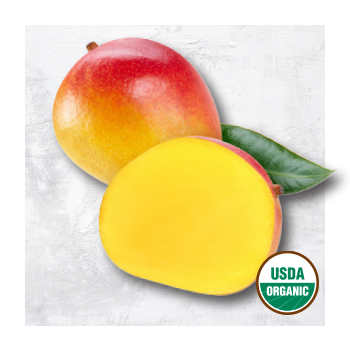


Sign-up for {N}power to get exclusive discounts, newsletters, members-only features, and more!

There’s a transportive power to the sweet juiciness of a perfectly ripe mango; with every bite you’re whisked away to a beach under swaying palm trees, basking in the warm golden sun. As you relax into this tropical vacation in your mouth, you’re also nourishing your body with a dose of vitamin C, lutein and zeaxanthin that support eye health, and fiber and digestive enzymes that support gut health.1 So put your feet up and let yourself savour the decadence of a mango… and be sure to make it organic!

You may have heard that you don’t need to buy organic mangoes, that they’re one of the cleaner fruits and less likely to be coated in pesticides. While it is true that mangoes tend to be lower in residues (yay!), one pesticide found on 15 percent of the USDA-tested samples is not so tasty.2 Thiabendazole is a fungicide the EPA classifies as “likely to be carcinogenic at doses high enough to cause disturbance of the thyroid hormone balance.”3 Carcinogens and endocrine disruptors with your mango? No, thank you! Not only does this pesticide put farm workers and mango lovers at risk, but as a fungicide it also disturbs the biodiverse soil mango orchards foster (more on that in a moment). Choosing organic certifies this nasty pesticide is kept off of your mangoes, and out of the soil!
Mangoes are world travellers. Though we do have a few mango-growing states in the U.S., a large amount is imported from Central and South America. Since these tasty fruits often travel great distances to reach our ready and welcoming bellies, it’s common to harvest them early and apply artificial ripening agents to ripen fruit when it’s closer to its consumer market. These agents mimic the kinds of gasses fruits produce as they ripen. When it comes to mangoes, conventional agriculture will sometimes use calcium carbide, a dangerous toxin with potential risks that include organ damage, heart disease, and cancer. Calcium carbide is often contaminated with heavy metals like arsenic and has been banned in many countries around the world. In the U.S., calcium carbide is banned in California and New Jersey, but allowed in other states.4 5 To be on the safe side of this highly hazardous risk, choosing organic ensures your mangoes are not treated with calcium carbide.
Mango trees grow large with dense branches that reach outward, with vibrant green leaves polka-dotted with bursts of the yellows and reds of their fruits. From their weaving branches to their vast and deep root systems, they offer habitats that support biodiversity. Delicate yellow flowers attract butterflies, bees, and other pollinators, and under the soil, mango trees that have fungal partners in their root systems contain more vital nutrients including phosphorous and zinc.6 These deep root systems also support carbon sequestration and help to prevent soil erosion.7 Conventional farming kills so much of this opportunity for biodiversity and environmental flourishing with pesticides that harm bees and deplete soil of vibrant invertebrates and fungal life. Choosing organic means choosing biodiversity and a healthier, happier planet for everyone. A tropical cheers to that!



Sign-up for {N}power to get exclusive discounts, newsletters, members-only features, and more!